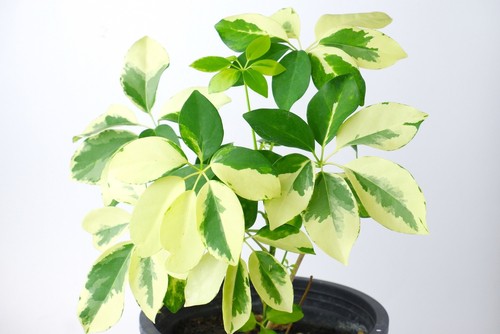Schefflera, also known as umbrella plant, is a popular houseplant that is easy to care for and adds a touch of greenery to any space. However, black spots on schefflera leaves can be a cause for concern for many plant owners. These spots can indicate a variety of issues, including pests, diseases, and environmental factors.
Identifying the cause of black spots on schefflera leaves is crucial for proper treatment and prevention. Common causes of black spots include overwatering, poor drainage, low humidity, and fungal or bacterial infections.
Pests, such as spider mites and mealybugs, can also cause black spots on leaves. Understanding the underlying issue is essential for effective treatment and preventing the problem from recurring.
Key Takeaways
- Black spots on schefflera leaves can indicate a variety of issues, including pests, diseases, and environmental factors.
- Identifying the cause of black spots is crucial for proper treatment and prevention, which may include adjusting watering habits, improving drainage, and treating pests or infections.
- Regular care, including maintaining proper humidity and avoiding overfertilizing, can help prevent black spots and keep schefflera plants healthy.
Check out these other related posts:
- Black Spots on Sage Leaves Safe to Eat
- Black Spots on Sage Leaves
- Black Spots on Rubber Plant Leaves
Understanding Schefflera
Schefflera, also known as umbrella plant or umbrella tree, is a tropical plant that is native to Taiwan and Hainan. It is a popular houseplant due to its attractive foliage and ease of care. Schefflera plants can grow up to 8 feet tall and have large, glossy leaves that resemble the shape of an umbrella.
Schefflera plants are known for their air-purifying qualities and are often used to improve indoor air quality. They are also known to be effective in removing harmful chemicals such as benzene and formaldehyde from the air.
Schefflera plants prefer bright, indirect light and can tolerate some shade. They require well-draining soil and should be watered when the top inch of soil is dry to the touch. Overwatering can lead to root rot and other problems.
Schefflera plants can be propagated through stem cuttings or by air layering. They can also be pruned to control their size and shape.
While schefflera plants are generally easy to care for, they can be susceptible to certain pests and diseases. Common pests include spider mites, mealybugs, and scale insects. Diseases such as bacterial leaf spot and Alternaria leaf spots can also affect schefflera plants.
One common problem that schefflera plants can experience is the development of black spots on their leaves. This can be caused by a number of factors, including environmental stress, pests, and diseases. Proper care and maintenance can help prevent the development of black spots on schefflera leaves.
Identifying Black Spots
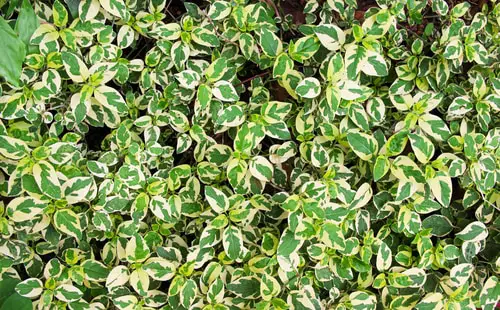
Schefflera plants are popular houseplants that are grown for their beautiful foliage. However, these plants are susceptible to various diseases and pests that can cause black spots on their leaves. Identifying black spots on Schefflera leaves is crucial to prevent further damage to the plant.
Black spots on Schefflera leaves can be caused by several factors, including fungal and bacterial infections, insect infestations, and environmental stress.
The black spots may appear as small, circular or irregularly shaped lesions on the leaves, and they may be accompanied by other symptoms such as yellowing, wilting, and leaf drop.
One of the most common causes of black spots on Schefflera leaves is leaf blight, a bacterial disease that can cause black spots on the foliage. This disease usually starts as small water spots on the leaves that slowly turn black, causing the leaves to die.
To prevent the spread of the disease, it is important to remove any affected leaves and destroy them.
Another possible cause of black spots on Schefflera leaves is Alternaria leaf spot, a fungal disease that can cause blackened, circular spots on the leaves. This disease is often associated with high humidity and poor air circulation.
To prevent the spread of the disease, it is important to avoid overhead watering and to provide adequate ventilation to the plant.
Black leaves on Schefflera plants indicate frost or cold damage. In addition, low humidity, lack of light, and heat stress can also cause blackened leaves. To prevent this, it is important to provide the plant with appropriate environmental conditions, such as moderate temperature, high humidity, and adequate light.
Black Spots on Schefflera Leaves – 4 Common Problems
Schefflera plants are known for their glossy green leaves that can add a touch of vibrancy to any room. However, black spots on the leaves can be a sign of an underlying problem. Here are some common causes of black spots on schefflera leaves:
1. Overwatering

Overwatering is a common cause of black spots on schefflera leaves. When the soil is constantly wet, it can lead to root rot, which can cause black spots on the leaves.
To prevent overwatering, it is important to allow the soil to dry out completely before watering again. Schefflera plants prefer well-draining soil, so make sure the pot has drainage holes.
2. Underwatering
On the other hand, underwatering can also cause black spots on schefflera leaves. When the soil is too dry, the plant will start to wilt and the leaves will turn black. To prevent underwatering, make sure to water the plant when the top inch of soil is dry to the touch.
3. Temperature and Humidity
Schefflera plants prefer warm temperatures and high humidity. If the plant is exposed to cold or frost, it can cause black spots on the leaves. Temperature stress can also cause black spots on the leaves. To prevent temperature stress, make sure to keep the plant away from cold drafts and direct sunlight.
4. Environmental Issues
Environmental issues such as excess water, frost, and cold damage can also cause black spots on schefflera leaves. To prevent environmental issues, make sure to keep the plant in a warm and humid environment. Avoid exposing the plant to cold drafts or direct sunlight.
Influence of Watering
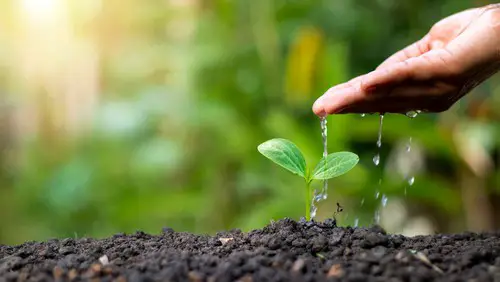
Watering is one of the most important factors that influence the health of a schefflera plant. Overwatering or underwatering can cause black spots on the leaves.
Overwatering is a common problem that can lead to root rot, which in turn can cause black spots on the leaves. When a schefflera plant is overwatered, the roots become waterlogged and cannot absorb oxygen properly. This can lead to the growth of harmful bacteria and fungi that cause black spots on the leaves.
On the other hand, underwatering can cause the leaves to wilt and turn yellow, which can also lead to black spots. When a schefflera plant is underwatered, the leaves become dry and brittle, making them more susceptible to damage from pests and diseases.
It is important to water a schefflera plant properly to prevent black spots on the leaves. The amount of water a schefflera plant needs depends on various factors such as the size of the plant, the type of pot it is in, and the environmental conditions.
Using a moisture meter can help determine when a schefflera plant needs water. A moisture meter measures the moisture content of the soil and indicates when it is time to water the plant.
It is also important to use the right type of water when watering a schefflera plant. Tap water can contain high levels of salts and minerals that can accumulate in the soil and cause black spots on the leaves. Using distilled or filtered water is recommended to prevent this problem.
Finally, it is important to avoid excess water on the leaves of a schefflera plant. Water-soaked leaves can create an environment that is conducive to the growth of harmful bacteria and fungi that cause black spots.
In summary, proper watering is crucial to prevent black spots on the leaves of a schefflera plant. Overwatering, underwatering, excess water, tap water, and water-soaked leaves are all factors that can contribute to the development of black spots.
Using a moisture meter, using the right type of water, and avoiding excess water on the leaves can help prevent this problem.
Role of Soil and Roots
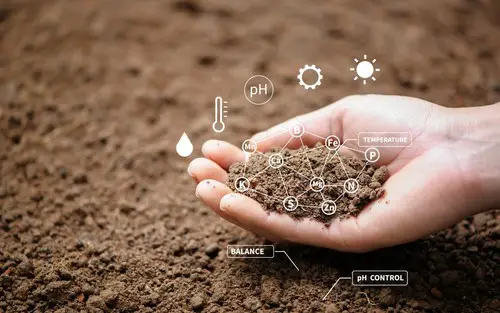
The soil and roots play a vital role in the health of schefflera plants. Schefflera plants require well-draining soil that is moist but not waterlogged. Overwatering can lead to root rot, which is a common cause of black spots on schefflera leaves.
Root rot is caused by a fungus that thrives in damp soil and attacks the roots, causing them to rot and decay. As the roots die, they are unable to absorb water and nutrients from the soil, which leads to the development of black spots on the leaves.
To prevent root rot, it is important to ensure that the soil is well-draining and that the roots are not sitting in water. If the soil is heavy and clay-like, it may be necessary to amend it with sand or perlite to improve drainage. It is also important to avoid overwatering the plant and to allow the soil to dry out slightly between waterings.
In addition to preventing root rot, it is important to ensure that the root system of the schefflera plant is healthy and well-established. A healthy root system will allow the plant to absorb water and nutrients from the soil, which will help to prevent the development of black spots on the leaves.
To promote a healthy root system, it is important to ensure that the plant is not root-bound and that the roots have room to grow. Repotting the plant into a larger container every 2-3 years can help to ensure that the root system remains healthy and robust.
Overall, the soil and roots play a crucial role in the health of schefflera plants. By ensuring that the soil is well-draining and that the roots are healthy, gardeners can help to prevent the development of black spots on the leaves and promote the overall health and vitality of the plant.
Impact of Light and Temperature
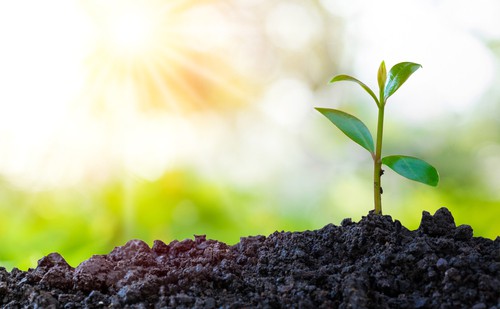
Schefflera plants are known for their ability to thrive in a wide range of light and temperature conditions. However, extreme variations in these factors can lead to the formation of black spots on the leaves.
In this section, we will discuss the impact of light and temperature on schefflera plants and how to prevent black spots from forming.
Light
Light is one of the most important factors that influence the growth and health of schefflera plants. These plants require bright, indirect light to thrive. Direct sunlight can scorch the leaves and cause them to develop black spots. On the other hand, insufficient light can cause the leaves to turn yellow and fall off.
To prevent black spots from forming due to light-related issues, it is essential to place the schefflera plant in a location that receives bright, indirect light. If the plant is exposed to direct sunlight, it is recommended to move it to a location that receives filtered light or to use a sheer curtain to diffuse the light.
Temperature
Temperature is another critical factor that affects the growth and health of schefflera plants. These plants prefer warm and humid environments but can tolerate a wide range of temperatures. However, extreme temperature variations can cause the leaves to develop black spots.
Schefflera plants are sensitive to cold temperatures and can suffer damage if exposed to temperatures below 55°F (12°C). Similarly, exposure to high temperatures above 90°F (32°C) can cause the leaves to turn brown and develop black spots.
To prevent black spots from forming due to temperature-related issues, it is essential to maintain a stable temperature range of 60°F to 85°F (16°C to 29°C). It is also recommended to avoid placing the plant near drafty areas or heating vents, which can cause temperature fluctuations.
Pests and Diseases
Schefflera plants are susceptible to various pests and diseases, which can cause black spots on the leaves. It is essential to identify the cause of the black spots to take appropriate measures to prevent further damage.
Pests
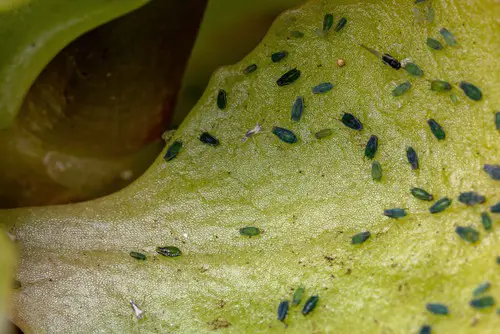
Pests like spider mites, aphids, mealybugs, thrips, and scale insects can infest Schefflera plants. These pests feed on the plant’s sap, causing damage to the leaves and stems. The infested leaves may turn yellow or brown, and black spots may appear.
To prevent pest infestations, it is essential to keep the plant healthy by providing it with the ideal growing conditions. Overwatering can cause stress to the plant, making it susceptible to pest infestations. Regularly inspect the plant for any signs of pests and isolate the infected plant to prevent the spread of pests to other plants.
In case of a pest infestation, prune the heavily-infested parts of the plant and apply neem oil or insecticidal soap to the affected areas. These products can help control and prevent pest infestations.
Diseases
Schefflera plants are also prone to various diseases, such as Alternaria leaf spot, root rot, and bacterial leaf spot. These diseases can cause black spots on the leaves and other symptoms like wilting and stunted growth.
To prevent diseases, it is crucial to provide the plant with well-draining soil and avoid overwatering. Avoid overhead watering, as it can cause the leaves to remain wet, creating a favorable environment for disease-causing pathogens.
If the plant is affected by a disease, prune the infected parts of the plant and apply a fungicide to prevent the disease from spreading.
Fungal and Bacterial Infections
Schefflera plants are susceptible to fungal and bacterial infections that can cause black spots on the leaves. Fungi and bacteria are microorganisms that can attack the plant, leading to leaf damage, discoloration, and death.
Fungal Infections
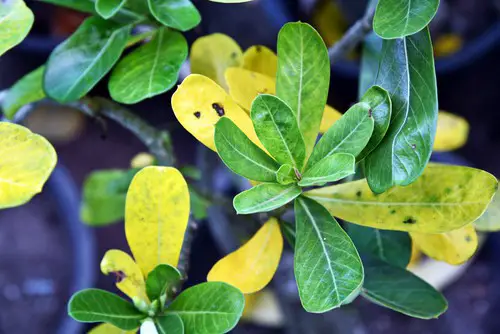
Fungal infections are caused by various types of fungi that can attack the Schefflera plant. Some common fungal diseases that cause black spots on the leaves include Alternaria leaf spot, powdery mildew, and downy mildew.
These fungal diseases can cause a range of symptoms, including dark spots on the leaves, yellowing, and wilting. Fungi thrive in warm, humid conditions, so it’s important to keep the plant in a well-ventilated area and avoid overwatering. Applying a fungicide can help protect the plant from fungal attacks.
Bacterial Infections
Bacterial infections are caused by various types of bacteria that can attack the Schefflera plant. One of the most common bacterial diseases that cause black spots on the leaves is bacterial leaf blight, caused by Xanthomonas campestris.
This disease can cause black spots on the leaves, yellowing, and wilting. Bacteria thrive in moist conditions, so it’s important to avoid overwatering and remove any dead or diseased leaves from the plant. Applying a bactericide can help protect the plant from bacterial attacks.
It’s important to note that fungal and bacterial infections can be difficult to diagnose, as the symptoms can be similar. If you suspect that your Schefflera plant is infected, it’s best to consult a professional or take a sample of the affected plant to a plant clinic for diagnosis.
Treatment and Prevention
Treating black spots on schefflera leaves requires identifying the underlying cause. Once identified, the appropriate treatment can be applied to prevent further damage to the plant. Here are some effective treatments and prevention methods:
1. Fungicide
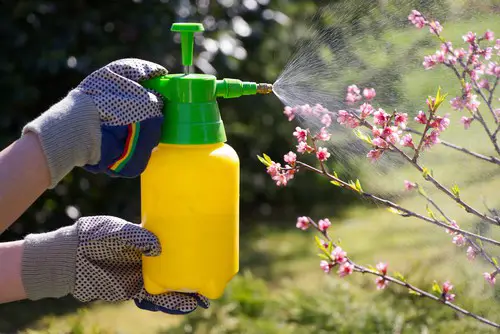
Fungicides can be used to treat black spots on schefflera leaves caused by fungal infections. Apply a fungicide according to the manufacturer’s instructions. It is essential to use a fungicide that is safe for schefflera plants. Copper fungicides are a good option for treating black spots on schefflera leaves.
2. Neem Oil
Neem oil is a natural fungicide that can be used to treat black spots on schefflera leaves. Mix a few drops of neem oil with water and apply it to the affected leaves. Neem oil is also effective in preventing future fungal infections.
3. Baking Soda
Baking soda is an effective treatment for black spots on schefflera leaves caused by fungal infections. Mix one teaspoon of baking soda with a quart of water and spray it on the affected leaves. Repeat this process every week until the black spots disappear.
4. Fertilization
Fertilization can help prevent black spots on schefflera leaves. Schefflera plants require regular fertilization to maintain their health. Use a balanced fertilizer that contains nitrogen, phosphorus, and potassium. Avoid over-fertilizing, as this can lead to nutrient burn and cause black spots on the leaves.
5. Bactericide
Bactericides can be used to treat black spots on schefflera leaves caused by bacterial infections. Apply a bactericide according to the manufacturer’s instructions. It is essential to use a bactericide that is safe for schefflera plants.
Repotting and Care

Repotting schefflera plants is an essential step in maintaining healthy growth and preventing black spots on the leaves. Houseplants need to be repotted every two to three years, while greenhouse or outdoor garden plants may require repotting more frequently.
When repotting, it is important to choose a pot that is one size larger than the current one to allow for growth.
To repot a schefflera plant, carefully remove it from its current pot, being mindful not to damage the roots. Gently loosen the roots and remove any dead or rotted ones. Fill the new pot with fresh, well-draining soil, and place the schefflera plant in the center. Fill the pot with soil, pressing it down firmly to eliminate any air pockets.
Proper care is also essential to prevent black spots on schefflera leaves. Schefflera plants prefer bright, indirect light, but can tolerate low light conditions. They should be watered when the top inch of soil is dry, being careful not to overwater as this can lead to root rot and black spots on the leaves.
Additionally, schefflera plants benefit from regular fertilization during the growing season with a balanced fertilizer.
Hanging baskets are a popular way to display schefflera plants, but they require special care. Hanging baskets should be watered more frequently than potted plants, as they dry out quicker. Additionally, it is important to choose a hanging basket with good drainage to prevent water from accumulating and causing root rot.
Maintaining Humidity
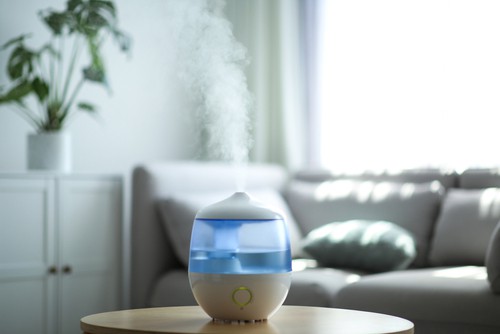
Schefflera plants require high humidity to thrive. Low humidity is one of the most common reasons for black spots on Schefflera leaves. When humidity is low, the leaves begin to lose their moisture at a faster rate due to a rise in transpiration. This leads to the formation of black spots on the leaves.
To maintain high humidity levels, one can use a tray of pebbles. Fill a tray with pebbles and water, then place the Schefflera plant on top of the pebbles. As the water evaporates, it creates a humid microclimate around the plant. This method is effective and inexpensive.
Another way to maintain humidity is by using a humidifier. A humidifier can be used to increase the humidity levels in the room where the Schefflera plant is located. This is especially useful during the winter months when indoor heating can cause the air to become dry.
It is important to note that while high humidity is necessary for Schefflera plants, too much humidity can also be harmful. Overly humid conditions can lead to the growth of mold and other harmful microorganisms. To avoid this, it is recommended to maintain humidity levels between 40-60%.
Overfertilizing Issues
Schefflera plants are sensitive to overfertilizing, which can lead to black spots on the leaves. Overfertilizing occurs when the plant receives too much fertilizer or when the fertilizer is applied in excess of what the plant can use.
This can lead to nutrient burn, which causes dead patches on leaves that are similar to black spots but with brown edges.
Fertilizers contain essential nutrients such as nitrogen, phosphorus, and potassium, which are necessary for plant growth. However, overfertilizing can cause an imbalance of nutrients in the soil, which can lead to plant stress and damage.
Nitrogen is one of the most important nutrients for plant growth, but when overused, it can cause excessive leaf growth and weak stems, making the plant more susceptible to diseases and pests.
To prevent overfertilizing, it is important to follow the manufacturer’s instructions on the fertilizer package. It is also recommended to use a slow-release fertilizer, which releases nutrients slowly over time, reducing the risk of overfertilizing. In addition, it is important to avoid fertilizing during the winter months when the plant is dormant.
If overfertilizing has occurred, it is important to flush the soil with water to remove any excess fertilizer. This can be done by watering the plant with plain water until the water runs out of the drainage holes at the bottom of the pot. It is also recommended to repot the plant in fresh soil to prevent any further damage.
Understanding Plant Physiology

Schefflera plants are part of the Araliaceae family and are known for their lush foliage. Like all plants, Schefflera relies on photosynthesis to produce food. Photosynthesis is the process by which plants use light energy to convert carbon dioxide and water into glucose and oxygen.
Chlorophyll, a green pigment found in plant cells, plays a crucial role in photosynthesis.
The vascular bundle system is responsible for transporting water, nutrients, and sugars throughout the plant. The vascular bundle is composed of two main components: xylem and phloem.
Xylem is responsible for transporting water and minerals from the roots to the leaves, while phloem transports sugars and other nutrients from the leaves to other parts of the plant.
The petiole is the stalk that connects the leaf blade to the stem. It contains the vascular bundle system and is responsible for transporting water and nutrients to the leaf. The stomata, tiny openings on the underside of the leaf, allow for gas exchange and water vapor release.
When Schefflera plants are healthy, their leaves are a vibrant green color. However, if the plant is stressed or diseased, black spots may appear on the leaves. These spots may be caused by a variety of factors, including fungal infections, bacterial infections, or environmental stress.
To prevent black spots on Schefflera leaves, it is important to maintain a healthy growing environment. This includes providing adequate light, water, and nutrients. Overwatering can lead to root rot, which can cause black spots on the leaves.
Similarly, underwatering can cause the plant to become stressed and more susceptible to disease.
Frequently Asked Questions
How do I identify bacterial leaf spot on schefflera leaves?
Bacterial leaf spot on schefflera leaves is characterized by small, water-soaked lesions that can vary in color from light brown to black. The lesions may also be surrounded by a yellow halo.
Over time, the lesions can merge and cause the leaves to become distorted. In severe cases, the leaves may drop from the plant.
What causes black spots on schefflera leaves?
Black spots on schefflera leaves can be caused by a variety of factors, including bacterial leaf spot, fungal infections, pests, overwatering, and excessive fertilizer. It is important to identify the underlying cause of the black spots in order to effectively treat the problem.
How can I prevent black spots from forming on my schefflera leaves?
To prevent black spots from forming on schefflera leaves, it is important to provide the plant with proper care. This includes ensuring that the plant is not overwatered, avoiding excessive fertilizer, and keeping the plant in a location with good air circulation.
Regularly inspecting the plant for pests and promptly treating any infections can also help prevent black spots from forming.
What is the best way to treat black spots on schefflera leaves?
The best way to treat black spots on schefflera leaves depends on the underlying cause of the problem. In some cases, simply improving the plant’s care can help the plant recover.
In other cases, treating the plant with a fungicide or bactericide may be necessary. It is important to follow the instructions on any treatment product carefully to ensure that it is used safely and effectively.
Are there any natural remedies for black spots on schefflera leaves?
There are several natural remedies that can be effective in treating black spots on schefflera leaves. These include neem oil, chamomile tea, and a mixture of baking soda and water. It is important to research the effectiveness of any natural remedy before using it on your plant.
Can black spots on schefflera leaves be a sign of a larger plant health issue?
Black spots on schefflera leaves can be a sign of a larger plant health issue, such as a pest infestation or a fungal infection.
It is important to inspect the plant thoroughly and identify the underlying cause of the problem in order to effectively treat the issue and prevent further damage to the plant.

Hey, I’m Lisa and I’ve been an avid gardener for over 30 years. I love writing, talking and living in the garden! Feel free to connect with me on my socials below

